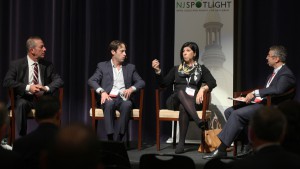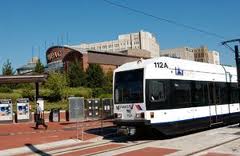New Jersey Future Blog
NJ Spotlight on Cities: Successful Development Requires a Community’s Blessing
October 26th, 2015 by New Jersey Future staff
This article is written by Sonia Schnee, video production and outreach coordinator for CivicStory, where the article originally appeared.

Left to right: Paul Silverman of SILVERMAN; Ron Beit of RBH Group; Christiana Foglio-Palmer of Community Investment Strategies, and moderator Peter Kasabach of New Jersey Future. Photo by Amanda Brown, NJ Spotlight.
The Oct. 16 NJ Spotlight on Cities conference offered a refreshing number of ideas about how to improve conditions in New Jersey’s cities. The day-long conference at the New Jersey Performing Arts Center was presented by NJ Spotlight, a nonprofit state-wide public policy news site.
The speakers at one stimulating panel, Development 2025: What Does the Future Hold? included Ron Beit, chief executive officer of RBH Group, LLC and President of RBH Management; Paul Silverman, co-founder and principal of SILVERMAN; and Christiana Foglio-Palmer, chief executive officer of Community Investment Strategies. RBH Group currently manages development projects in Newark, SILVERMAN is based in Jersey City, and Community Investment Strategies has projects across the state.
Panel Moderator Peter Kasabach, executive director of New Jersey Future, launched the discussion by asking about the key components of development. The panelists highlighted a global and national trend showing that citizens are actually flocking toward cities rather than to the suburbs. Why? In addition to the conveniences that come with living in a city (e.g., access to public transportation, restaurants, entertainment), people want to be part of a community, and they want to live among neighbors on whom they can depend.
The panelists cited Camden, Newark, and Jersey City as having explosive potential for growth. As developers, they explained, you want to see an entire city succeed. It is important to be involved with and to support the success of all corners of a city, even those that you don’t own property in. If all corners succeed, then all citizens succeed.
The panelists explained that a holistic vision is necessary when planning a development project and that developers have a duty to preserve three things: 1) the people who already live in the neighborhood in which you are going to build, 2) the area’s historic landmarks, and 3) the cultural institutions of the neighborhood. Mixed communities are vibrant communities, and it is part of the developer’s responsibility to ensure that residents don’t get pushed out of their own neighborhoods.
Paul Silverman voiced concern that the borough of Manhattan, for example, could become less interesting if it were to become affordable only for “the very wealthy.” No matter what the development project may be – residential, commercial, or mixed use – a key to success is gaining the blessing of the surrounding community.
Ron Beit cited the East Ward Ironbound section of Newark as one example of a healthy partnership, where construction of a new building – the world’s largest indoor vertical farm (operated by AeroFarms) – will soon begin. The RBH Group worked with the Ironbound Community Corporation to explore the needs of the community and discovered, among other findings, that residents of this former industrial neighborhood wanted green jobs. The 69,000-square-foot indoor farm is now projected to create employment opportunities for between 70 and 80 local residents.
Beit also mentioned the development of educational spaces as another powerful way to re-invigorate neighborhoods. Schools may draw in 1,000 families, twice a day, to an area. Those families then frequent the nearby restaurants and shops, thereby stimulating local businesses. Teachers’ Village in downtown Newark is a major redevelopment project that involves converting parking lots and dilapidated buildings into three charter schools, housing for teachers, and retail space. Teachers’ Village is also surrounded by Newark’s six universities.
Silverman said a major component of successful development is investing in the city’s infrastructure, as it affects the developer’s ability to preserve old buildings and build new ones. He cited Jersey City’s Hamilton Square condominium complex as an example of adaptive re-use of historic buildings, in which a former hospital building was converted into a mixed-use space – a walkable urban neighborhood with access to PATH train, light rail, and ferry stations.
Christiana Foglio-Palmer identified the perception of safety as an important factor in attracting new residents. She described one residential redevelopment project that she worked on in Elizabeth, where safety issues “kept her up at night.” The building had seen high crime and gang and drug activity and was “pulling the rest of Elizabeth down.”
By renovating the space for the area’s residents and creating a hydroponic farm, which in turn generated green jobs, Community Investment Strategies was able to change the way the area was perceived. With the addition of increased building security, the crime rate went down.
Foglio-Palmer concluded that if one respects the people living in an area, the people will in turn respect the building and the environment. As a developer, she said, “You want to leave the place better than you find it.”
Leaving your home, neighborhood, community, and eco-system a better place than you find it, is wise advice for us all.
















